
ImJa 솔루션
ImJa 보드에서 자바 언어를 사용하여 UDS 통신하는 방법을 알아보겠습니다. UDS는 Unix Domain Socket의 약자로 이름에서 알수 있듯이 유닉스에서 사용하는 내부 프로세스끼리 통신하는 IPC 중 하나입니다. 즉, 같은 시스템 안에서 실행하는 프로세스 사이에 데이터를 주고받는 통신 방법이지요.
UDS는 매우 편리한 IPC 방법 중 하나이지만, 유닉스에서만 사용하는 방법이라 크로스 플랫폼을 지원하는 자바 프로그램에서는 아마도 생소할 것입니다. 아마도 자바에서는 프로세스끼리 통신해야 한다면 UDP/IP를 사용할텐데, UDS는 UDP/IP보다 훨씬 가볍고 IP 주소 대신에 파일 이름으로 상대방을 구별하기 때문에 사용하기도 편합니다.
이름부터 UDS라서 UDP/IP와 같은 것이라고 생각하는 분도 계시지만, UDP/IP 방식뿐만 아니라 TCP/IP식으로도 사용할 수 있습니다. UDS에 대한 자세한 설명은 아래 글을 참고하여 주십시오.
http://forum.falinux.com/zbxe/index.php?document_srl=406064&mid=network_programming
UDS를 TCP/IP 또는 UDP/IP 방식으로 선택해서 사용하지만, 대부분 UDP/IP 방식으로 사용합니다. 전송한 만큼 데이터를 받아서 처리하는 것이 편하기 때문이지요. ImJa보드에서 제공하는 ImJa 라이브러리도 UDS를 UDP/IP 방식으로 제공합니다.
아래는 UDS 통신으로 문자열 데이터를 받으면 에코하는 예제입니다. UDP/IP는 IP 주소로 타겟을 지정한다면, UDS는 내부 프로세스끼리의 통신이라서 IP 주소로는 구별할 수 없어서, 각 프로세스별로 서로 다른 파일 이름을 사용하게 됩니다. 예제를 보시면 UDS 통신 객체를 생성할 때 파일 이름을 사용하는 것을 볼 수 있는데, 다른 프로세스는 이 파일로 데이터를 전송하면 해당 프로세스에게 전달됩니다.
package udsSample;
import java.nio.ByteBuffer;
import com.falinux.imja.Poll;
import com.falinux.imja.Uds;
public class UdsSampleMain extends Uds {
private Poll poll = null;
private final ByteBuffer bufUdpRead = ByteBuffer.allocateDirect(1024);
private final ByteBuffer bufUdpWrite = ByteBuffer.allocateDirect(1024);
/**
* UdsSampleMain
* @param udsFileName
*/
public UdsSampleMain(String udsFileName) {
super(udsFileName); // Uds 오브젝트 생성
poll = new Poll(); // 통신 라이브러리 초기화
this.open(); // Uds open
poll.rebuild(); // 통신 객체 목록 갱신
}
@Override
public int onRead(long handle) {
int readBytes = this.read(bufUdpRead); // 수신된 데이터 읽기
byte[] buf = new byte[readBytes]; // byte배열 설정
bufUdpRead.flip(); // 읽은 데이터 설정
bufUdpRead.get(buf); // 데이터를 byte배열에 설정
System.out.print("received:"); // 받은데이터 문자열 출력
System.out.println(new String(buf)); // 받은데이터 문자열 출력
bufUdpRead.compact(); // bytebuff포지션 재설정
bufUdpWrite.put(buf); // 받은 데이터를 송신 버퍼에 설정
bufUdpWrite.flip(); // 송신 데이터 설정
this.write(bufUdpWrite, "/tmp/2nd.uds");// 데이터 송신
bufUdpWrite.compact(); // 송신 bytebuff포지션 재설정
return readBytes;
}
@Override
public int onWrite(long handle) {
// TODO Auto-generated method stub
return 0;
}
@Override
public int onError(long handle) {
// TODO Auto-generated method stub
return 0;
}
@Override
public int onHup(long handle) {
// TODO Auto-generated method stub
return 0;
}
@Override
public int onTimeOut(long handle) {
// TODO Auto-generated method stub
return 0;
}
@Override
public int onDisconnect(long handle) {
// TODO Auto-generated method stub
return 0;
}
public void run () {
while (true) {
poll.pollDoLoop(100);
}
}
public static void main(String args[]) {
new UdsSampleMain("/tmp/1st.uds").run();
}
}
UDS 샘플을 작성하기 위해 이클립스에서 프로젝트를 생성합니다.
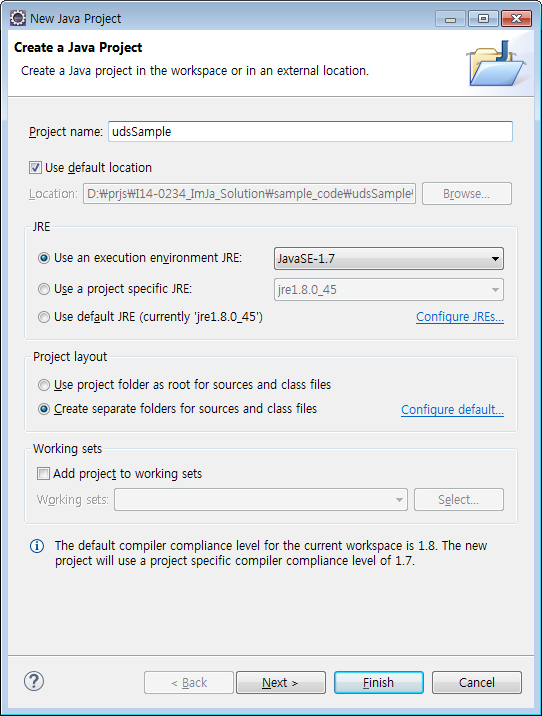
▲ UDS 샘플에 맞추어 프로젝트 이름을 udsSample로 정했습니다.
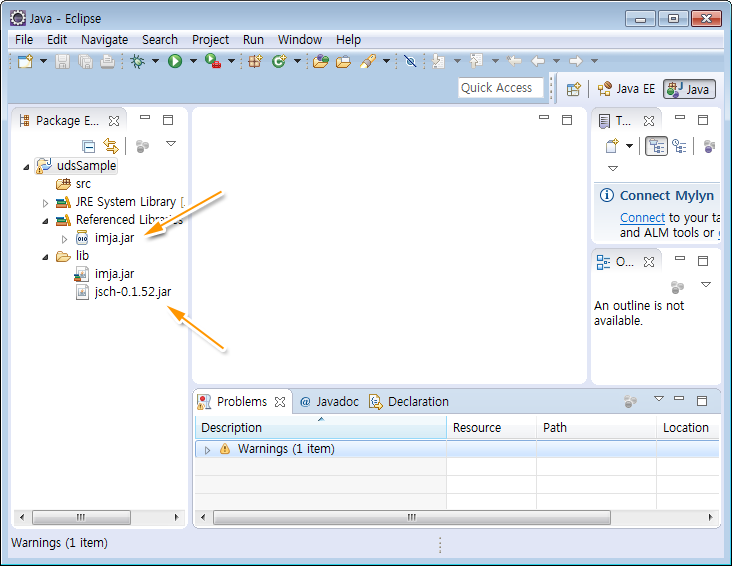
▲ 프로젝트가 생성되었습니다. 아래 글을 참고해서 jsch.jar과 imja.jar 라이브러리를 추가합니다.
필요한 라이브러리가 추가되었습니다. 이제 소스 코드를 작성하면 됩니다.
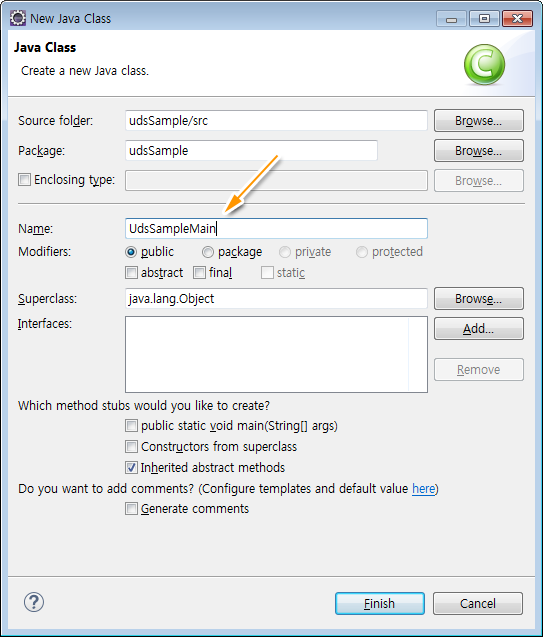
▲ src 폴더를 마오른쪽 버튼 클릭 후 New>>Class를 실행합니다. 샘플 객체 이름을 udsSampleMain이라고 입력합니다.
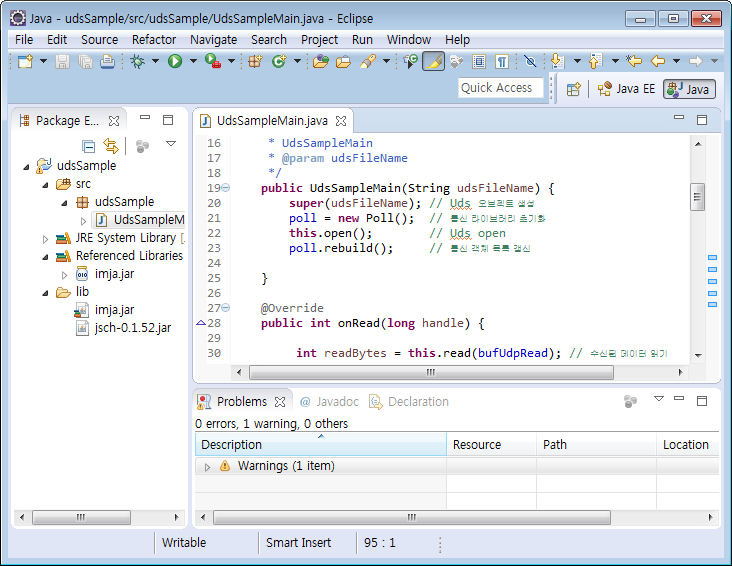
▲ udpSampleMain에 프로그램 소스 코드를 입력합니다.

▲ 소스 코드를 작성했으니 Build.xml과 build.propertyiies를 생성합니다. Build.xml과 build.propertyiies 내용은 아래와 같습니다.
>>> Build.xml
<?xml version="1.0" encoding="UTF-8"?>
<!-- 프로젝트 이름을 입력한다. -->
<project name= "ImJa_example" basedir= ".">
<!-- 빌드 프로퍼티 파일 -->
<property file= "build.properties" />
<!-- Java Compile-->
<target name= "compile" description= "Compile!!!" depends= "">
<echo message="------------------------------" />
<echo message="Java Compile!!!! " />
<echo message="------------------------------" />
<javac target= "${java.target}"
nowarn="true"
deprecation="true"
debug="true"
listfiles="false"
failonerror="true"
optimize="false"
includeantruntime="false"
srcdir="${basedir}/src"
destdir="${basedir}/bin"
encoding="${java.compile.encoding}">
</javac>
</target>
<!-- make jar-->
<target name= "make_jar_nfs" depends= "compile">
<echo message="------------------------------" />
<echo message=" Make Jar : ${jar.name}.jar" />
<echo message="------------------------------" />
<mkdir dir= "./jar" />
<jar destfile="${nfs.dir}/${jar.name}.jar" basedir="${basedir}/bin">
</jar>
</target>
<!-- target device upload-->
<target name= "target_device_upload" depends= "make_jar_nfs">
<echo message="------------------------------" />
<echo message=" Target device Upload" />
<echo message="------------------------------" />
<scp file="${nfs.dir}/${jar.name}.jar"
todir="${target.id}@${target.ip}:${target.dir}"
password="${target.pw}"
trust="true"/>
</target>
</project>
>>> build.propertyiies
# NFS folder nfs.dir=nfs #java encoding java.compile.encoding=UTF-8 #java compile version java.target=1.7 #java jar name jar.name=appUdsSample #upload target info target.ip=192.168.2.75 target.id=root target.pw=falinux target.dir=/home
build.propertyiies를 보면 생성할 실행 파일 이름은 appUdsSample이고 ImJa 보드의 IP는 192.168.2.75, 로그인 ID와 암호는 각각 root에 falinux이며, 실행 파일 저장 위치는 /home이 되겠습니다.
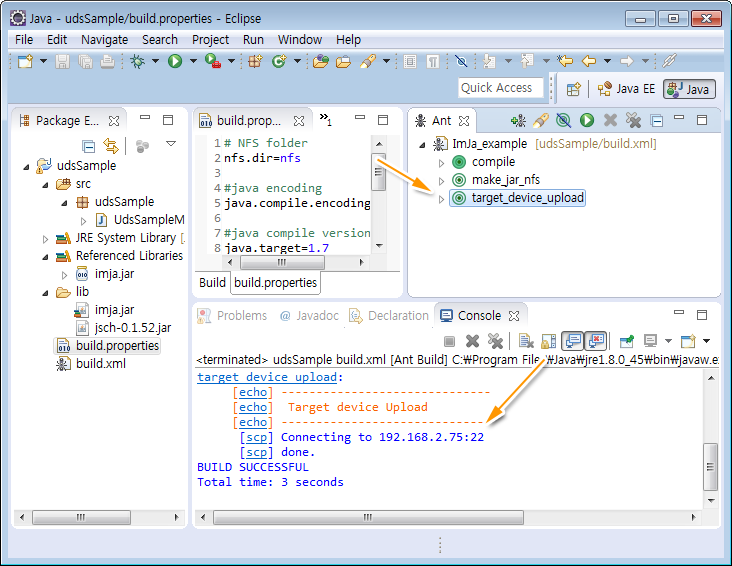 ▲ Ant 스크립트를 이용하여 소스 파일을 컴파일하고 ImJa 보드로 실행 파일을 전송합니다.
▲ Ant 스크립트를 이용하여 소스 파일을 컴파일하고 ImJa 보드로 실행 파일을 전송합니다.
ImJa 보드에서 예제 실행 파일을 실행합니다. 실행 방법은 위 이미지에서처럼 아래와 같이 입력하여 실행합니다.
]# java -cp appUdsSample.jar udsSample.UdsSampleMain
자, 샘플을 실행해야 하는데, 결과를 보기 위해서는 appUdsSample에 UDS를 이용하여 문자열을 전송해 주는 샘플이 하나 더 필요합니다. 지금까지의 프록젝트 생성 방법을 참고하셔서 appUdsTester를 생성합니다.
package udsTester;
import java.nio.ByteBuffer;
import com.falinux.imja.Poll;
import com.falinux.imja.Uds;
public class UdsTesterMain extends Uds {
private Poll poll = null;
private final ByteBuffer bufUdpRead = ByteBuffer.allocateDirect(1024);
private final ByteBuffer bufUdpWrite = ByteBuffer.allocateDirect(1024);
/**
* UdsTesterMain
* @param udsFileName
*/
public UdsTesterMain(String udsFileName) {
super(udsFileName); // Uds 오브젝트 생성
poll = new Poll(); // 통신 라이브러리 초기화
this.open(); // Uds open
poll.rebuild(); // 통신 객체 목록 갱신
}
@Override
public int onRead(long handle) {
int readBytes = this.read(bufUdpRead); // 수신된 데이터 읽기
byte[] buf = new byte[readBytes]; // byte배열 설정
bufUdpRead.flip(); // 읽은 데이터 설정
bufUdpRead.get(buf); // 데이터를 byte배열에 설정
System.out.print("received from 1st:"); // 받은데이터 문자열 출력
System.out.println(new String(buf)); // 받은데이터 문자열 출력
bufUdpRead.compact(); // bytebuff포지션 재설정
return readBytes;
}
@Override
public int onWrite(long handle) {
// TODO Auto-generated method stub
return 0;
}
@Override
public int onError(long handle) {
// TODO Auto-generated method stub
return 0;
}
@Override
public int onHup(long handle) {
// TODO Auto-generated method stub
return 0;
}
@Override
public int onTimeOut(long handle) {
// TODO Auto-generated method stub
return 0;
}
@Override
public int onDisconnect(long handle) {
// TODO Auto-generated method stub
return 0;
}
public void run () {
long tmCurrent = 0L;
long tmBefore = 0L;
while (true) {
poll.pollDoLoop(100);
tmCurrent = System.currentTimeMillis();
if ((tmCurrent - tmBefore) > 1000) {
tmBefore = tmCurrent;
bufUdpWrite.put( "2nd message".getBytes());
bufUdpWrite.flip();
this.write(bufUdpWrite, "/tmp/1st.uds");
bufUdpWrite.compact();
}
}
}
public static void main(String args[]) {
new UdsTesterMain("/tmp/2nd.uds").run();
}
}
appUdsTester는 아래 명령으로 실행하면 됩니다.
]# java -cp appUdsTester.jar udsTester.UdsTesterMain
appUdsSample가 실행된 상태에서 appUdsTester를 실행하면 1초마다 appUdsTester에서 appUdsSample로 문자열이 전송됩니다. 실행되는 모습은 아래와 같습니다.
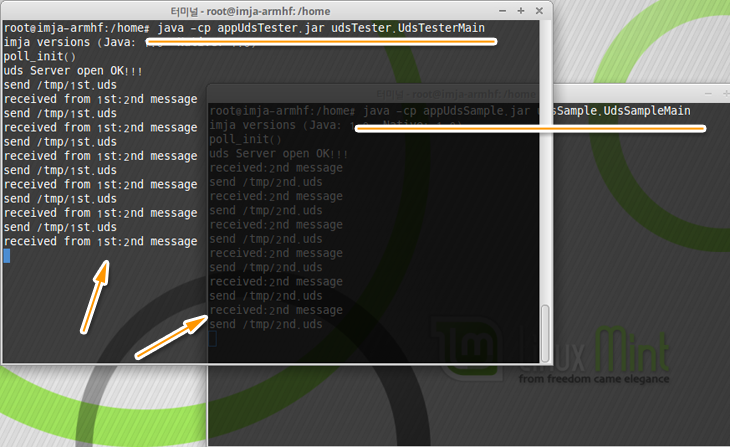
UDS도 역시 ImJa 라이브러리를 이용하면 TCP/IP, UDP/IP, CAN, 시리얼 통신처럼 같은 방식으로 프로그램을 작성할 수 있습니다. 통신 방식은 달라도 프로그램 코딩 방법은 같아서 ImJa 라이브러리를 이용하면 프로그램을 쉽게 작성할 수 있고 관리하기가 편합니다.
다음 시간에는 UDS 샘플 코드에 대해 자세히 설명하겠습니다.






